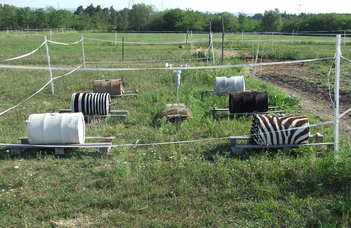Experimental study of the functions of zebra stripes: a new thermophysiological explanation

The adaptive benefits of zebra stripes have been disputed since Wallace (1867) and Darwin (1871), but among the 18 existing theories, only 1 is experimentally confirmed, namely the visual parasite (tsetsefly and horsefly) repellence of zebra stripes. We demonstrated that dark host animals are much more attractive to horseflies than bright ones, and animals with striped/spotted fur patterns are horsefly-repellent. The reasons of these are unknown. Here we present a new thermophysiological explanation: On hosts with dark and thus in sunshine warm coat, horseflies can easier find blood vessels by means of vein-generated temperature gradients due to the lack of other disturbing heat gradients, and during blood sucking they can fly away faster from the backlash of hosts, because due to the warmer microclimate their wing muscles can function quicker. On hosts with inhomogeneous coats it is difficult to find veins by thermoreception because of disturbing heat gradients at the borders of stripes/spots. The surface temperature of bright hosts is not high enough, even in sunshine, to ensure the quick functioning of wing muscles necessary to a successful escape from the host’s backlash. We test this with horseflies, horses, cattle, zoo zebras, and in field observations, experiments and measurements performed with test surfaces of different optical/thermal characteristics. We also test experimentally the theory of the alleged cooling effect of zebra stripes because of convective air eddies with measurements using thermocamera and Schlieren-technique, and with thermodynamical measurements of host animal models. This research is supported by the Hungarian grant NKFIH 123930.
Project leader(s): Horváth Gábor
Participant(s): Kriska György; Pereszlényi Ádám; Takács Péter; Tóth Tímea; Polgár Szabolcs
Webpage: arago.elte.hu
Publication(s):
- Gábor Horváth, Ádám Pereszlényi, Dénes Száz, András Barta, Imre M. Jánosi, Balázs Gerics, Susanne Åkesson (2018) Experimental evidence that stripes do not cool zebras. Scientific Reports 8: 9351 (12 pages, doi: 10.1038/s41598-018-27637-1) DOI .
- Gábor Horváth, Tamás Szörényi, Ádám Pereszlényi, Balázs Gerics, Ramón Hegedüs, András Barta, Susanne Åkesson (2017) Why do horseflies need polarization vision for host detection? Polarization helps tabanid flies to select sunlit dark host animals from the dark patches of the visual environment. Royal Society Open Science 4: 170735 (16 pages, doi: 10.1098/rsos.170735) DOI .
- Miklós Blahó, Ádám Egri, Dénes Száz, György Kriska, Susanne Åkesson, Gábor Horváth (2013) Stripes disrupt odour attractiveness to biting horseflies: Battle between ammonia, CO2, and colour pattern for dominance in the sensory systems of host-seeking tabanids. Physiology and Behavior 119: 168-174 DOI .
- Ádám Egri, Miklós Blahó, György Kriska, Róbert Farkas, Mónika Gyurkovszky, Susanne Åkesson, Gábor Horváth (2012) Polarotactic tabanids find striped patterns with brightness and/or polarization modulation least attractive: An advantage of zebra stripes. Journal of Experimental Biology 215: 736-745 DOI .

